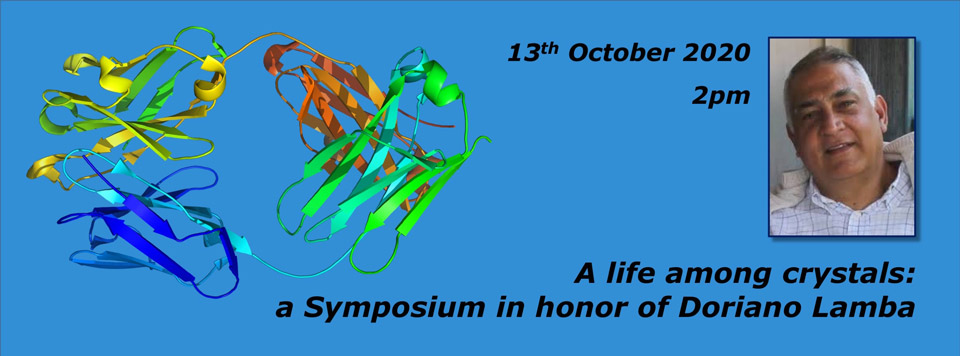

This symposium aims to celebrate Doriano’s scientific life and achievements and to gather most of his collaborators and friends, over a fruitful and productive “life among crystals”.
Doriano Lamba has been one of the main players in the development of biophysics and structural biology in Italy.
After a degree in Chemistry at the University of Rome “La Sapienza”, working with Carmelo Giacovazzo on the application of direct methods to small molecules phasing, Doriano joined the CNR – Institute of Structural Chemistry “G. Giacomello” in Montelibretti (Rome), where he was involved in the crystallography of small to medium molecules of natural origin with biological and pharmacological activities. Doriano thus developed a strong interest in the structural aspects of carbohydrates, interest that led him to carry out a PhD at the University of Leeds. Indeed Leeds was one of leading centres in the foundation of modern molecular biophysics and structural biology, with a thriving and internationally renowned community, starting from the legacy of William Bragg and William Astbury, to scientists such as Tony North, Peter Knowles, William Mackie, Bernard Sheldrick, Simon Philips and many others.
Doriano then decided to focus on macromolecular crystallography. He joined the laboratory of Wolfram Bode and Robert Huber, at the Max Planck Institut für Biochemie, in Martinsried. Although Robert Huber obtained the Nobel prize in 1988 for the structure of the photosynthetic reaction centre (together with H. Michael and J. Deisenhofer), the Munich laboratory has been at the forefront of the development of protein crystallography techniques since the ‘70s, and has been particularly successful in the determination of the structures of medically important proteases and their inhibitors. Doriano gave an important contribution by determining the structure of the blood coagulation factor thrombin with an inhibitor, and especially the structure of the fibrinolytic enzyme tissue-plasminogen activator. In addition to their role in biological pathways, both proteins have a great importance for the pharmaceutical industry, for the development of anticoagulants and thrombolytic therapies. Here Doriano not only refined his technical skills, but also developed an interest in structures with a medical, pharmaceutical or biotechnological importance.
Back in Italy, he moved to Trieste where he had a key role in establishing the Trieste Outstation of the CNR Institute of Crystallography, and contributed to develop the crystallography beamline XRD1 at the nascent synchrotron facility Elettra. His research activity spans a large range of scientific areas, from the enzymology of acetylcholine esterase as target for Alzheimer disease drugs, to structural and functional analysis of neurothrophins (NGF, BDNF, proNGF, proBDNF, etc.), to the study of neutralizing antibodies targeting NGF-mediating pain (anti-TrkA-receptor and anti-NGF).
He has established collaborations with all the major scientific institutes in Trieste (Elettra, Sissa, ICGEB, ICTP and the University of Trieste); he also has a position as Adjunct Professor at the prestigious Scuola Normale Superiore di Pisa.
